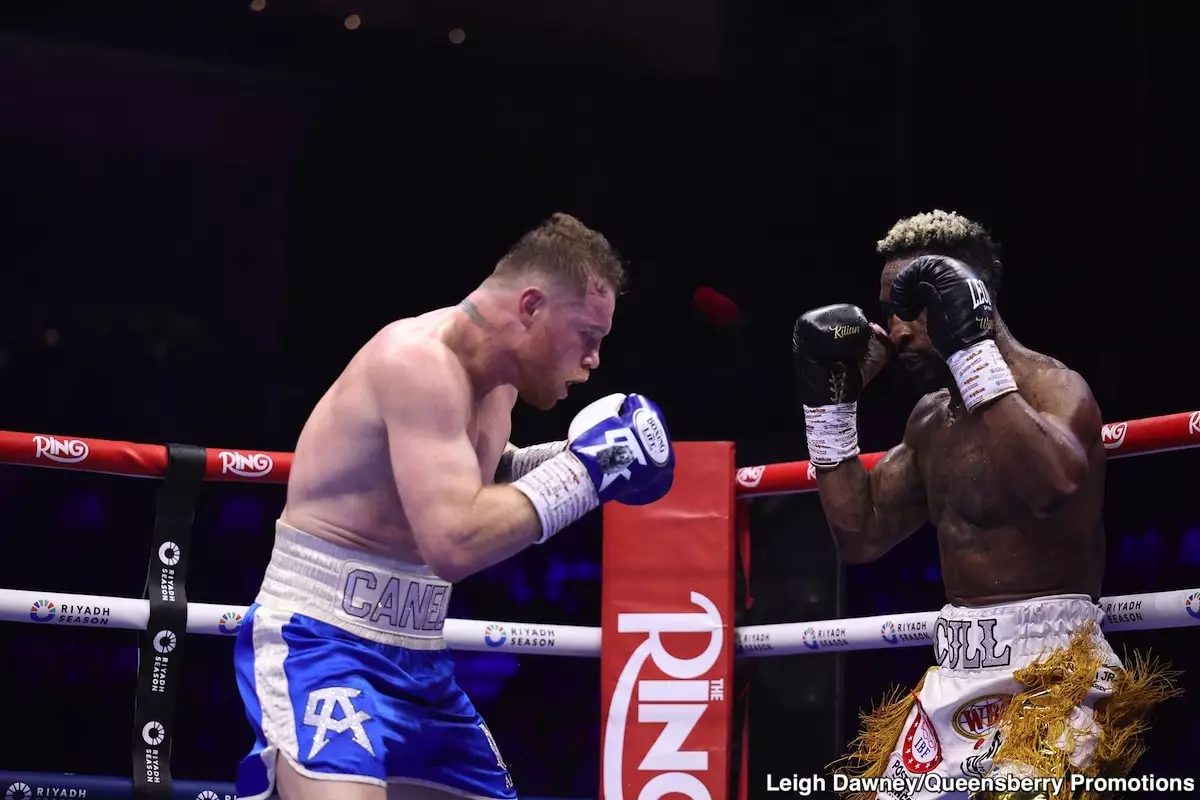In the upcoming showdown on September 13th at the Allegiant Stadium in Las Vegas, boxing fans are eager to witness a clash of contrasting styles and physiques. Trainer Bob Santos’s endorsement of Canelo Alvarez over Terence Crawford underscores a broader truth in the sport: physical attributes often dictate the outcome of high-stakes fights. Canelo’s impressive record, coupled with his robust frame and proven power at 168 pounds, suggests that he’s entering the fight with a tangible advantage. His ability to maintain weight, combined with years of experience in higher weight classes, makes him a formidable opponent for the smaller, albeit undefeated, Crawford.
Canelo’s proven resilience and ability to absorb punishment further reinforce the belief that his size and power could be insurmountable barriers for Crawford. It’s not just about straightforward strength—it’s about the leverage, punch resistance, and territorial dominance Canelo can establish early on. In boxing history, fighters with significant size and heft, like George Foreman or Sonny Liston, have leveraged their physicality to establish early control and wear down opponents. The matchup leans heavily in Canelo’s favor, especially considering Crawford’s recent struggles and the physical toll of moving up three weight divisions without a proper tune-up.
Age and Inactivity: Striking Disadvantages for Crawford
Age is a silent but relentless adversary in boxing, and Crawford’s recent trajectory raises questions about his physical readiness. At nearly 38, Crawford’s body language during training camp has hinted at fatigue and aging signals that are difficult to ignore. As fighters age, their agility, recovery, and reaction times tend to decline, which could spell trouble against a seasoned, powerful opponent like Canelo.
Furthermore, Crawford’s inactivity since his last bout in August 2022 adds layers of concern. A half-year hiatus between fights, especially when stepping up in weight, suggests a lack of recent competitive sharpness. His performance in the previous fight was less convincing—a narrow decision that could have gone either way indicates potential vulnerabilities. Without recent warm-up fights at 168, Crawford’s transition to facing the larger, more experienced Canelo appears ill-timed, akin to a sprinting athlete jumping into a marathon without adequate preparation.
The Strategic Mindset: Conservation Versus Aggression
Canelo’s boxing intelligence has been a cornerstone of his career. His past fights reflect a pattern of meticulous conservation of energy and body—waiting for the right moment and avoiding unnecessary risks. Fighters like Floyd Mayweather executed a similar game plan against bigger opponents, relying on counter-punching and strategic conservatism to secure victories. Santos’s insight suggests Canelo will employ a calculated approach, conserving his strength for crucial exchanges rather than engaging in prolonged exchanges that favor Crawford’s speed and agility.
Paid handsomely, with reports citing a $100 million payday, Canelo’s motivation transcends mere victory; it’s about cementing legacy and demonstrating resilience against youthful challengers. Facing Crawford, who is trying to bridge three divisions without a recent warm-up, Canelo’s experience and ring IQ could tip the balance in his favor. It’s a fight where patience, power, and tactical discipline will be paramount.
Crawford’s Challenges: The Risks of a Bold Move
Stepping up so dramatically in weight without prior acclimatization is a gamble. Crawford is an exceptional talent, but boxing is a domain where physical adaptation is crucial—especially at the elite level. His latest fight against Madrimov, a narrow win marked by signs of wear, hints at the physical strain he’s enduring. The absence of a proper tune-up at 168 leaves gaps in his readiness, making this step-up reminiscent of a high-wire act with little buffer for error.
The age factor compounds this problem. Aging bodies don’t recover as swiftly, and the prolonged break might have sapped some of Crawford’s quickness and reaction capabilities. While his technical prowess and conditioning can’t be dismissed, the raw power and size advantage that Canelo brings to the table might be enough to overwhelm him early, forcing him into a defensive shell or worse—an early stoppage.
Final Analysis: The Power Dynamics of Victory
This fight underscores a fundamental principle in boxing: physical dominance often shapes fights at the highest level. Canelo’s size, strength, and experience are assets that he’s likely to leverage early. Crawford’s challenge is not just overcoming a superior opponent but doing so without the luxury of recent proven form in this new weight class. The strategic depth, physical conditioning, and mental fortitude coming into this bout favor Alvarez, especially given his ability to conserve energy and deliver decisive power shots when necessary.
Ultimately, this clash could be a testament to the glaring differences that come with moving up divisions without ample preparation. It’s a reminder that in boxing, size isn’t just a number—it’s a tangible edge that can define destiny in the ring. And in this case, the edge appears to be firmly within Canelo Alvarez’s grasp.

